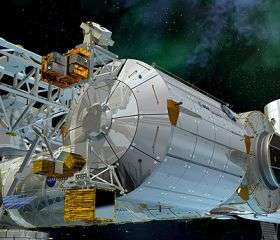The European Columbus space laboratory set to reach ISS

With NASA’s announcement today of the launch of Space Shuttle Atlantis on 6 December, ESA astronauts Hans Schlegel, from Germany, and Leopold Eyharts, from France, are set to carry ESA’s Columbus laboratory to the International Space Station.
Atlantis is now scheduled to lift off from launch pad 39-A at NASA’s Kennedy Space Center in Cape Canaveral, Florida at 22:31 CET. Docking with the ISS is scheduled for the third day of the mission (Saturday 8 December at 19:14 CET). Landing is currently scheduled to take place on Monday 17 December at 18:29 CET.
ESA’s Columbus laboratory is the most important European mission to the ISS to date and the cornerstone of Europe’s contribution to this international endeavour. Once Columbus is launched, assembled to the Space Station and verified, ESA will become an active partner in the operations and utilization of mankind’s only permanent outpost in space.
As the first European laboratory devoted to long-term research in space, Columbus will further expand the science capabilities of the ISS. In its interior, the Columbus laboratory will provide accommodation for experiments in the field of multidisciplinary research into biology, physiology, material science, fluid physics, technology, life science and education. In addition, its external payload facility hosts experiments and applications in the field of space science, Earth observation and technology.
Columbus will be transported into Earth orbit in the Shuttle’s cargo bay, pre equipped with five internal rack. Two of its external experiment facilities will be stowed separately in the Shuttle’s cargo bay and attached to the outside of the laboratory module structure in orbit. German ESA astronaut Hans Schlegel will play a key role in two of the three spacewalks or EVA (Extra-Vehicular Activity) scheduled for the mission. During the mission’s first EVA, Schlegel will help to install and power up the laboratory.
During his long duration stay on the ISS, Eyharts will play a key part in the installation, activation and in-orbit commissioning of Columbus and of its experimental facilities. Once in orbit, Columbus will be monitored from ESA’s Columbus Control Centre located within DLR’s German Space Operations Centre in Oberpfaffenhofen, near Munich.
Eyharts is also likely to be onboard ISS for the launch of Jules Verne, Europe’s first Automated Transfer Vehicle, an unmanned supply ship carrying cargo to the ISS, including food, air and water. Jules Verne ATV is scheduled for launch on an Ariane 5 launcher early next year. Eyharts will return to Earth at the end of Shuttle mission STS-123 (currently manifested for launch not earlier than 14 February 2008).
For the launch of this milestone mission, ESA and the German Space Agency, DLR, are organising a live video event at ESA’s Columbus Control Centre located in DLR/GSOC premises in Oberfaffenhofen (near Munich). Other local events will also be held at ESA’s establishments. ESA experts, and top representatives from national space agencies or organisations as well as industry representatives will be on hand for interviews. See accreditation form linked on right.
The launch and the whole mission can also be followed on the web at: www.esa.int/columbus .
Source: ESA





















